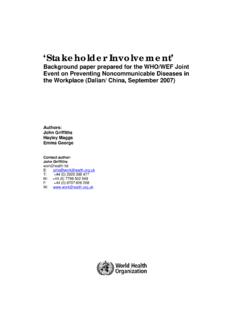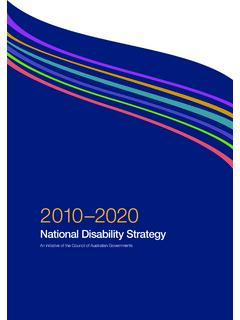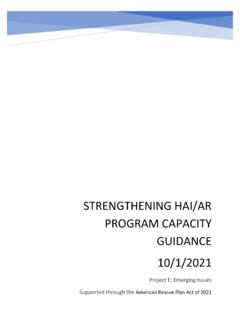Transcription of Sustainable Operations - Carbon and Energy Reduction …
1 Estates Directorate Carbon and Energy Reduction strategy March 2018 Estates Directorate Carbon and Energy Reduction strategy Version control Policy name: Sustainable Operations Carbon and Energy Reduction strategy Version: Date published: March 2018 Policy owner: Carl von Reibnitz Authors: John Cole and Claire Soroczynski Consultation: BEIS Next review date: March 2019 Version history Version Date Reason for change A 01/08/2017 New template CvR 23/10/2017 Amendments 25/10/2017 Updates 3/11/2017 Updates 13/12/2017 Updates 01/03/2017 Final Sustainable Operations Carbon and Energy Reduction strategy Contents 1 Executive Summary 2 2 Introduction and Scope 3 3 Key Drivers and Policy 5 4 Baseline and Targets 7 5 stakeholder Mapping 8 6 Carbon Management Processes 10 7 Project Identification and Implementation 12 8 Economics, finance & commercial 15 9 Contact details 15 Annex 1.
2 Energy and Carbon strategy Commitments 16 1 Sustainable Operations Carbon and Energy Reduction strategy 1 Executive Summary Reducing Energy demand and choosing low Carbon solutions is a key priority for the Ministry of Justice (MoJ) to help the UK and Central Government meet its Carbon targets, to minimise the impacts from climate change, and to reduce operating costs. MoJ is the second largest departmental contributor of Carbon emissions after the MOD and has a significant role within to play in ensuring the Government meets its Greening Government Commitments (GGC) including reducing greenhouse gas emissions. MoJ has developed this Carbon and Energy Reduction strategy to provide an evidenced based strategic document to help deliver these Carbon targets and reduce Energy demand. The strategy has been developed based on a review of existing processes and systems against the requirements of known standards such as the Carbon Trust Standard and the Energy Management System Standard ISO 50001.
3 This document provides information on MoJ s approach to delivering Carbon and Energy reductions, focusing on our baseline, our achievements so far, how we will work with stakeholders, how projects will be identified, managed and delivered and how we see the short term, medium term and long-term Reduction in Carbon emissions will be delivered across our estate. MoJ s ambition is to achieve and if possible exceed a 38% Carbon Reduction by 2019 20. This document sets out a strategy to drive down Carbon emissions to 2020, and looks forward to 2025. Reducing Carbon emissions from the custodial estate is a key priority as these sites contribute the majority of MoJ s emissions. However, the strategy also addresses the non-custodial estate, in particular court buildings and key administrative sites. Dedicated resources have been committed across MoJ, including HMPPS, and HMCTS, and resource levels will be kept under review to ensure successful implementation of this strategy .
4 The strategy commits MoJ to progressing specific short, medium and long-term objectives to ensure effective Energy and Carbon management. These commitments will be reviewed and updated on a regular basis. A full list of our commitments is set out at Annex 1. 2 Sustainable Operations Carbon and Energy Reduction strategy 2 Introduction and Scope Scope This strategy covers the period 2017 20 but looks forwards to 2025, and will be reviewed at least annually. It covers all the key parts of MoJ including HMPPS, HMCTS, HQ and its arm s length bodies. Figure 1 provides an outline of this Carbon and Energy Reduction strategy . Figure 1 Implementing Carbon management in a complex organisation such as the MoJ requires regular reviews and adjustments to ensure it remains relevant and appropriate. The strategy is therefore based on a cyclical process with reviews and checks to ensure that plans evolve in response to changing targets, regulation, technologies, utility costs, commercial routes, and stakeholder responsibilities.
5 Reducing our Carbon emissions will also be realised by reducing our overall demand for Energy , improved processes and behaviour change. Our plans include, but are not limited to: Reducing the size of the estate and better utilisation of the remaining buildings Selection and use of Energy efficient buildings, equipment and controls, for example through the Government Buying Standards Improving thermal performance 3 Sustainable Operations Carbon and Energy Reduction strategy Improvements in technology (these will be reflected in MoJ Technical Standards) Pilot projects, lessons learned and post project evaluations Education of key stakeholders, estates staff and FM providers and end-users Better processes for data collection, benchmarking and monitoring and targeting. Where feasible the remaining Energy demand will come from Low or Zero Energy sources.
6 We recognise that decarbonisation of the national Energy infrastructure and new, innovative technologies will also play an important role in MoJ delivering this strategy . 4 Sustainable Operations Carbon and Energy Reduction strategy 3 Key Drivers and Policy UK Climate Change Act (2008) The Climate Change Act 2008 is a key driver for Sustainable Energy management as it mandates a minimum 80% Reduction in Carbon emissions by 2050 ag ainst a 1990 baseline; and sets legally binding Carbon budgets: Carbon budget 2 (2013 17): 31% Carbon budget 3 (2018 22): 37% (by 2020) Carbon budget 4 (2023 27): 51% (by 2025) Carbon budget 5 (2028 2032): 57% (by 2030) This activity will also contribute to Goal 13 of the United Nations Sustainable Development Goals (SDGs), which were agreed in September 2015, to take urgent action to combat climate change and its impacts.
7 Greening Government Commitments The Greening Government Commitments set out the actions UK government departments and their agencies will take to reduce their impacts on the environment. These targets require government to, amongst other things, reduce its greenhouse gas emissions by at least 32% by 2020 against a 2009 10 baseline. This 32% target has been exceeded three years early, with a 33% Reduction by the end of 2016/17, and BEIS is currently working with departments to set more stretching targets for 2020. MoJ Sustainable Operations Policy, November 2017 This strategy supports the MoJ Estate Directorate Sustainable Operations strategy which sets out the Ministry of Justice aims and objectives for improving the sustainability of its Operations , in line with the cross-Government targets the Greening Government Commitments 2016 20.
8 Regulatory Context The UK Government has committed to providing 15% of its Energy needs from renewable sources. This includes a significant increase in renewable electricity generation. With an increased proportion of renewable Energy , the electricity grid is becoming increasingly decarbonised. Over the long term the Government projects this decarbonisation to continue. Changes to the grid Carbon factor will influence the choice of technologies and Energy Reduction strategies that will be employed across the MoJ Estate on the short, medium and long term. For example, BEIS has issued guidance that gas fired Combined Heat and Power (CHP) should be considered transitional technology preferably not commissioned after 2023 as the Carbon factors by that time would no 5 Sustainable Operations Carbon and Energy Reduction strategy longer make it a favourable technology to reduce Carbon emissions against other low Carbon technologies.
9 The impact of our participation in two greenhouse gas emissions trading schemes are a key regulatory factor in this strategy : i. The Carbon Reduction Commitment Energy Efficiency Scheme, administered by the Environment Agency, require us purchase and surrender allowances relating to our annual Carbon emissions. This strategy will enable us to reduce our emissions and therefore reduce the amount of allowances we are required to buy and sell. ii. MoJ is legally obliged to purchase Carbon trading allowances under the European Union Emissions Trading System (EU ETS), to offset the use of coal at HMP Wymott and HMP Garth. Our proposals to replace the coal fired boilers will negate the need to purchase these allowances. Technology Context Technology options constantly evolve often in parallel with a changing regulatory landscape.
10 New technologies enter the market, whilst costs or efficiencies change with other technologies making them more or less attractive. This strategy takes account of this through a continual programme of re-evaluation alongside pilot projects to ensure the most appropriate technologies are being implemented. MoJ Technical Standards will be reviewed regularly to align with best practice and reflect our operational requirements. 6 Sustainable Operations Carbon and Energy Reduction strategy 4 Baseline and Targets Table 1 below is the GGC 2016 2020 targets for greenhouse gas emission reductions for MoJ contributing to the overall Government target. In March 2018 MoJ committed to a new target of 38% Reduction in Carbon dioxide emissions by 2019 20 on the 2009 10 baseline, having met the previous GGC target of 22% improvement. We also commit to setting stretch targets for 2020, 2025 and 2030 before 2019, and to work with BEIS to ensure our approach aligns to any cross-Government commitments.













